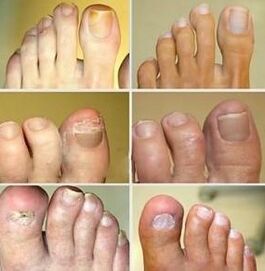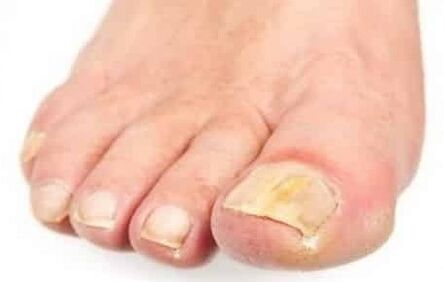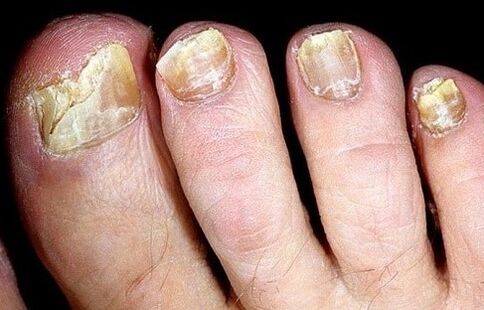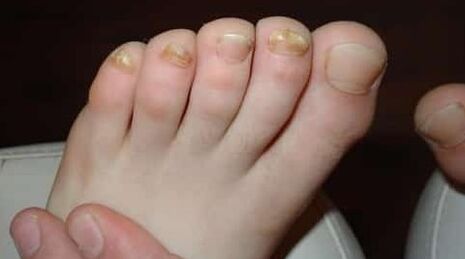Onychomycisosis is the pathology that destroys the nail plate.Fungi Eats Custards - The architectural foundation of nails.The infection falls into the cell space and begins to divide.At the advanced stage, pathology can affect the skin, intermittent areas of the feet, and high heels.

Causes of nail fungi
It is easy to get infected with thyroidoma.Infections may lurk on the beach, public souls, swimming pools.The possibility of capturing fungi from infected relatives or acquaintances (using shared life) is high.
There are several major prerequisites that can inspire viruses into the body:
- Weak immune system - reduced protection due to infectious or inflammatory diseases;
- Vascular pathology (venous occlusion) violates the work of internal organs (diabetes), which leads to blood circulation problems in the lower limbs;
- The minor damage to the skin on the feet (abuses, microcracks, corn, corn) is caused by wearing tight shoes;
- Ignore diaper rash and heavy sweating in the lower limbs;
- Violated prudent measures - try someone else's shoes, visit public places without slippers, and ignore the hygiene of the legs.
Types of nail fungi
Thyroid disease can cause several types of fungi.For example, skin plants appear in the form of clouds of nails.There are yellow spots formed on the edges or in the middle of the board.Additionally, longitudinal stripes along the region can be observed.
Yeast fungi can cause deformation of the nail plate.She was very delicate and began to leave her position and became gray.The metabolism in the damaged cells worsens and furrows appear on the nail roller.In addition, inflammation, edema, and redness appear on the adjacent epidermis, and the disappearance of the nail skin is observed.
If there is already a disease that causes nail nutrition disorders, mold can damage the nail plate.In this case, the plate also has shades, with its color variations (from light yellow and green to brown, even black).
To find out the causes and pathogens of negative changes in the skin and nails, you must contact an expert.Independent determination of the disease and its treatment without consulting a doctor may have consequences.
Disease stage

The siblings of the nails gradually affect healthy cells.The disease has several stages of development, and each disease has its own specific manifestations.
The first stage of tumor disease (normal plants) does not show brightness.In most cases, it will be hidden.The first sign - the nails are a little fading out, their color changes, microcracks and yellow spots form in round or longitudinal form, and nodules appear.Newbie fungi may be accompanied by itching and burning.Since the symptoms resemble other diseases (psoriasis, liver disease), it is difficult to correctly identify the infection in the initial stage.
If treatment time does not begin, the disease will enter the next stage - hypertrophy.Nails thickened and dark.deformation of the plate, its crown shape and damage.
The late form of nail disease is further repelled by the intense thinning of the nail plate.The adjacent skin turned blue and there was an unpleasant smell.
symptom
Thyroid disease most often affects the nails on the legs and suffers less frequently with both hands.The disease starts with the thumb and little finger (touch the outer edge), which smoothly affects all plates.
The main symptoms of thyroid disease will help determine fungal infection:
- The appearance of strips or green tones of strips and spots under the nails;
- clouds of plates, whose color changes (from yellow to dark brown);
- The skin around the nails is red and peeled;
- The appearance of roughness on the feet and between the fingers;
- Mold formation on the nails.
Types of Nail Fungal Diseases
Thyroid disease is usually classified by the appearance of the affected area.Since the classification characteristics are the appearance of fungi on the nails, they are distinguished among the three species depending on clinical manifestations:
- atrophic or intestinal disease – The nail plate is significantly affected by the degree of rejection by the nail bed;
- A thick appearance, where a look that loses its natural luster will deform with various forms, even a look that is damaged along the edges, changing its color (white or black) and structure (more obvious);
- Normal nutrition - A feature with a minimum level of damage, in which the nail plate does not thicken, remains brilliant and smooth, but causes external conversions due to spots, stripes and other visible changes in natural transparency and color.

In foreign countries, there is another classification according to which fungi on the nails are divided into species according to the specific location of the lesion:
- In total, the entire nail plate is covered by the pathogenic process;
- Distal - in damaged form, protruding only on the free edge of the nail of the nail located above the fingertips;
- Proximal end, where the edge of the plate appears below the nail roller, is destroyed (opposite to the free edge of the nail!);
- The lateral form of the injury affects the sides of the nail plate.
The pathological appearance
Fungal nail disease in the population has external similarities with other dermatology of neurologic properties.Depending on the stage of pathology, nails start to look unhealthy because they lose their natural sheen and transparency.They are smooth, even they become thick and deformed, and are covered in various colors (usually white or dirty yellow).The soft tissue around the keratin layer destroyed by the parasite is also involved in inflammatory responses, swelling and ulcers.
If we consider the situation of nailboard damage from the perspective of disease dynamics, we can divide it into three consecutive stages:
- In the first stage, there is little sign except for the slight blunt, dots or stripes on the board.
- In what So calls the obvious stage, rapid replacement of the initial stage, all the symptoms of thyroidomatosis become obvious.
- The advanced stage is the final degeneration of the nails, which can be supplemented by the unpleasant odor of rotting tissue.
Causes of nail deformation
Mold, yeast-like fungi and skin fungi can cause contagious diseases of the nails (Onychomycisosis), which show similar symptoms.All types of fungi deform on the nails on the legs or arms, changing their transparency, gloss, color.The changes in nails not only occur with myomycosis, but also with injuries, chronic paronichia (inflammation of nail rollers), psoriasis, hand eczema, dermatitis.Before you can draw conclusions about fungal infections, you need to consider all possible options.
Symptoms of fungi
The various classifications of nail fungi, depending on the type and manifestation, may have completely different signs and symptoms, so it is important to determine it (psoriasis, eczema, stray lichen and skin plants).Superficial thyroid disease on the fingers is manifested almost immediately after infection, considering the symptoms and signs of fungi on the nails of the legs and arms:
- Thickening plate;
- Fragile, brittle or torn nails are not only near the edges, but also on the entire surface;
- twisted form, scaly structure;
- The initial stage is the loss of luster and elasticity.
- If the nails turn black (in the case of a person using dyed or mechanical parts regularly, not for the expense);
- Nails collapse under the skin;
- The beginning of dynamic disorders, the overall decline in immunity, strength, and lethargy may generally decline.
- Itching between children and between feet is particularly obvious.
- Examination from nail beds is a very common phenomenon, almost the final stage before the nail is completely lost, which is called Onycholisis.You can feel pain on your fingers and find a little unpleasant odor.
- The skin becomes dry, cracks, rashes appear, and it may even be the appearance of blood or soucon.
- The mold under the nails is white or yellow circle, depending on the type of fungus, it can be bright, dull, with contoured edges and muddy structures.

Before starting to take the initiative, it is necessary to minimize the negative impact of the external environment to eliminateCauses of fungiUnder the nails on the legs:
- The warm and humid environment is perfect for the growth of various microorganisms, trying to dry shoes after walking, wearing socks only from natural materials that provide normal heat and air exchange;
- Foot fungi usually occur due to poor immunity, you can tread barefoot on the floor, pick up the infection, and take vitamins to avoid this;
- Frequent nail extensions may be one of the causes of formicrobial disease, limiting the surgery to up to 1 course of treatment within six months;
- The most complicated thing is sympathy - this is the fungus caused by proactive controversy.They penetrate the hollow between the nails and fingers, and can last for a while during the sleep phase and then grow rapidly.Most of the time, they are infected in public use (pools, showers, solariums) and during shoe surgery for others.
Common types of painkillers
There are many ways to get infected by leg fungal infection, but it is only possible to have direct contact with the pathogen.Most of the time, this happens during the use of someone else’s shoes or breaking personal hygiene rules.Skin fungi on the legs are usually manifested by the destruction of the dermis, which are reflected in the form of peeling.In this case, epidermal lesions are caused by the fact that the infection penetrates deep into the skin, destroying its structure.
Modern medicine has identified the following options for foot fungal damage, with different symptoms and treatment options for each foot:
- Enterophile disease is the most common form of disease manifestation.Symptoms are usually located between 3 and 4 fingers, less between 4 and 5 fingers, and look like a crack covered by a white film.It can secrete a certain amount of fluid, peeling off the border and signs of diaper rash.Signs of fungi in the legs may be accompanied by weak itching.This fungus on the legs and fingers can initially appear completely without symptoms, but the structure of the skin will undergo significant changes in the future.
- Fungi with squamous high mastoids can be distinguished by affecting severe peeling and keratosis of the epidermis.It is characterized by a wide variety of dermatitis, mainly unique.This is another disease, where fungi can be clearly seen on the legs.The main symptom of the disease is the appearance of erythema in the affected area with obvious boundaries, a painful pink nodule.It comes with weak itching, cracks in the feet, dryness, pain, yelling and nail damage.Thyroid disease, which is usually accompanied by this fungus, can lead to nail stratification.
- Vesicle fungi are one of the rarest types of infection that affects the skin of the legs.The disease is called the formation of vesicles - bubbles with liquid content, which then form erosion, which is dangerous for infection.The main signs of fungal cysts are different: the appearance of blisters, up to 1 cm in diameter, and itchy and weak;
- Erased fungus.In the initial stage, there is a slight peeling on the legs and the appearance of small cracks, which externally affect the upper layer of the epidermis.
- The fungus is dyshidrotot, and its infection is only found in medical practice, with 8% of patients infected with mycotic diseases.It is mainly located on the soles and domes of the foot, manifested in the form of bubbles, gradually merged into one, then a gap occurred, followed by widespread erosion.The danger of this fungus is the possibility of connecting bacterial infections, as pathogenic microorganisms can easily penetrate the resulting wound.
- The transdiaphragm not only occurs independently, but is also an accompaniment of the scaly shape of the leg fungi.It manifests between the fingers of the feet and is characterized by severe itching and burning, diaper rash and erosion.
- Eight-Streptococcus is another common option for damage, which is the fungus of the nails on the legs.It usually develops from the free edge of the nail plate, with the initial stage characterized by the appearance of macula, after which the disease progresses with sagging and full leave of nails.It is usually accompanied by other forms of fungal lesions;
- Candidate fungus, also known as yeast erosion, is located in the trans-matter space.In this case, fungi on the legs look like the concentration of an inflamed skin area, which may be surrounded by small-shaped pustules.

















